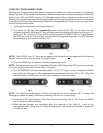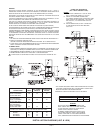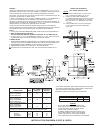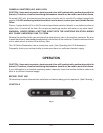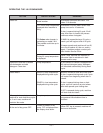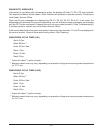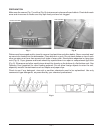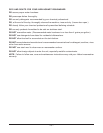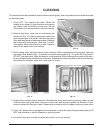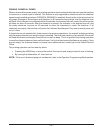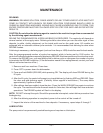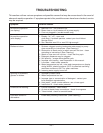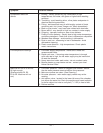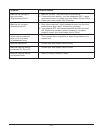
– 21 –
Symptom Possible Causes
Unexpected results on 1. Etching - usually caused by any combination of high
dishes. temperatures, soft water, soft glass or high alkaline washing
solutions.
2. Tarnishing - avoid washing silver, silver plates and pewter in
chemical-sanitizing machines.
3. Pitting - stainless steel may pit with lengthy contact of foods
containing salt, fruit juices, vinegar, etc. Wash immediately.
4. Black or gray marks - may have been rubbed with aluminum.
5. Brown stains - may be due to high iron content in water supply.
6. Chipping - improper loading or ware is too delicate.
7. Fading of china patterns - usually due to high water temperature
and strong detergent. Check that china is dishwasher compatible.
8. Wooden ware damage - avoid washing in dishwasher.
9. Rust on cast iron - seasoning is lost in dishwasher. Avoid
dishwasher cleaning.
10. Plastic ware distortion - high temperatures. Check plastic
ware's instructions.
Low-temperature readings. 1. Low water supply temperature - make sure it meets the
recommended limits.
2. Rapid cycle use - if incoming water temperature is low and
cycle use rate is high, the hot water supply may be insufficient
to meet the demand.
3. Heavy ware load cools wash water - do not overload racks.
4. Booster heater or sump heater set low - contact your local
Hobart Service Office.
Machine will not fill or will not 1. Low water pressure - check for clogged hose strainer; ensure
fill high enough. the site water pressure meets minimum flow pressures.
(Display shows E0, E2, 2. Make sure probes are clean. (See Cleaning.)
E3 or E4. Machine will not 3. No water pressure - main water supply valves may not be
run). working.
4. Anti-siphon valve - located in the lower left area of the chamber
just above the water line. Drain the machine and insert toothpick
or similar object into hole to verify ball (
3
/16" OD) is free to float.
5. Delime machine.



